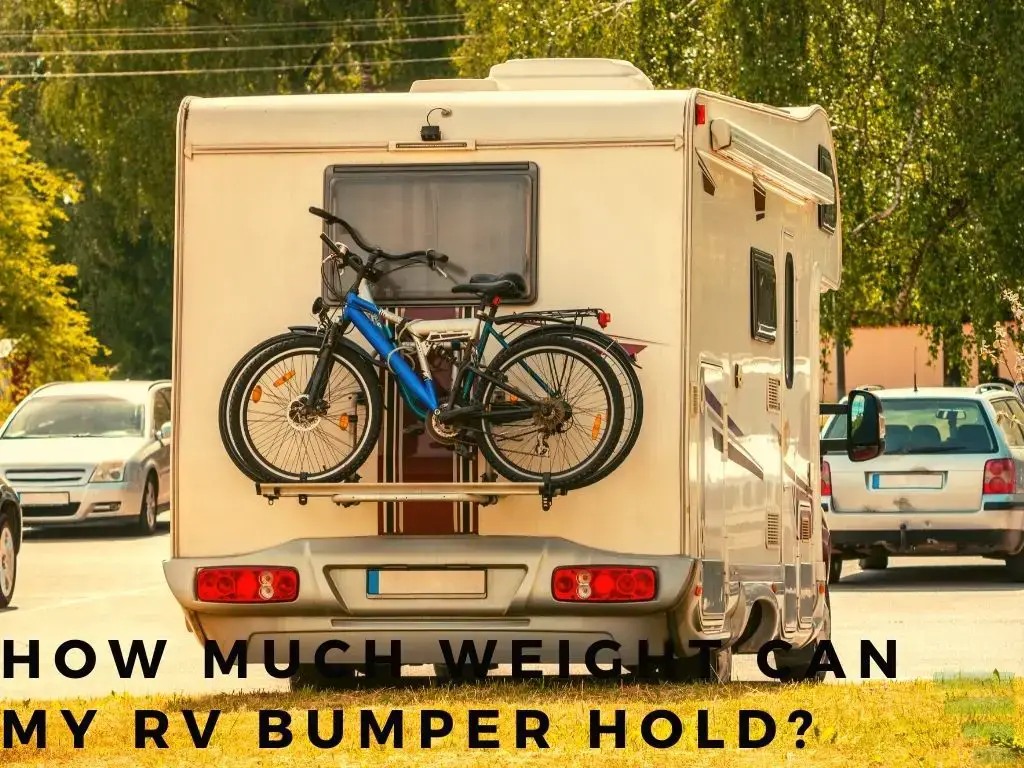When you want to carry more stuff with your RV, an RV bumper is a great choice. But do you know how the answer to the question of “How much weight can my RV bumper hold?“. You’ll need to make sure that you don’t put overweight on it.
Well, most RV bumpers can carry up to 300 pounds. The bumper is constructed by using a plywood material and other materials are put on it. The raised area is measured with a scale and the bumper’s weight limit can be determined from that data.
There are some benefits related to RV bumpers, such as they reduce vibrations. When an RV bumps, there is no damage to the vehicle. It has been proven that it can be used as a weight-bearing surface for accessories like lights, wiring, and plumbing. The bumper also lasts longer because it does not experience the same wear as the rest of your RV does.
Table of Contents
What is RV Bumper?
In the context of recreational vehicles (RVs), a bumper refers to the protective structure located at the rear of the vehicle. The RV bumper is typically made of steel or another durable material and is designed to provide protection to the rear of the RV, especially in the event of a collision or impact.
The primary function of an RV bumper is to absorb and distribute some of the force from a rear-end collision, helping to minimize damage to the vehicle’s body and other components. It serves as a buffer between the rear of the RV and any potential hazards, such as curbs, posts, or other vehicles.
Additionally, the RV bumper often has other practical uses. It can serve as a mounting point for accessories such as bicycle racks, cargo carriers, or towing equipment. Some RV bumpers also feature storage compartments or tube-like extensions that can accommodate items like sewer hoses or fishing rods.
It’s important to note that not all RVs have the same type of bumper. The design, material, and functionality can vary depending on the make and model of the RV. Some RVs may have more robust bumpers with integrated hitches for towing, while others may have simpler bumpers primarily intended for protection and minor accessory attachment.
How Much Weight Can My RV Bumper Hold?
The weight capacity of an RV bumper can vary depending on the specific make and model of the RV. It’s essential to consult the owner’s manual or manufacturer’s specifications for your particular RV to determine the exact weight capacity of the bumper.
In general, RV bumpers are designed to support a certain amount of weight, typically ranging from 100 to 300 pounds. This weight capacity is intended for light items such as bicycle racks, cargo carriers, or lightweight accessories.
However, it’s crucial to note that not all RV bumpers are designed or reinforced to support heavy loads or towing. If you are planning to attach towing equipment or carry substantial weight on the bumper, it is recommended to use a specific hitch or towing system that is approved and designed for the purpose. This will ensure the safety of your RV and prevent any potential damage to the bumper or other components.
Again, it’s best to refer to the manufacturer’s specifications or consult the owner’s manual for accurate information on the weight capacity of your RV’s bumper. This will provide you with the most reliable and up-to-date information regarding the weight limitations and usage guidelines.
>>> Get this support racket for your RV Bumper on Amazon
Factors Affecting RV Bumper Weight Capacity
Structural Integrity of the Bumper
The overall strength and structural integrity of the bumper are crucial. A well-built and robust bumper will typically have a higher weight capacity compared to a flimsier or less sturdy one. Bumpers with reinforcements or additional support are often capable of handling heavier loads.
Material Composition of the Bumper
The type of material used in the construction of the bumper can impact its weight capacity. Steel is a common material for RV bumpers due to its strength and durability. However, the thickness and quality of the steel can vary, influencing the bumper’s ability to bear weight. Other materials, such as aluminum, may be used in some cases, but their weight capacities might be lower compared to steel.
Design and Construction Quality
The design and construction quality of the bumper also contribute to its weight capacity. A well-engineered bumper with solid welds and proper reinforcement will generally have a higher weight rating. The design should distribute weight evenly across the bumper to prevent concentrated stress points.
Installation Method and Hardware
The way the bumper is installed and the hardware used can impact its weight capacity. Proper installation, including securely fastening the bumper to the RV’s frame, is crucial for optimal weight-bearing capabilities. Additionally, using high-quality and appropriate mounting hardware, such as bolts or brackets, that are designed to withstand weight can contribute to the overall strength of the bumper.
It’s important to consider these factors and adhere to the manufacturer’s guidelines and specifications for your specific RV model to ensure safe and proper use of the bumper.
Exceeding the weight capacity can result in structural damage, compromised safety, or potential accidents, so staying within the recommended limits is crucial.
Determining the Weight Capacity of Your RV Bumper
Manufacturer Specifications
The most reliable and accurate source of information is the manufacturer’s specifications for your specific RV model. Consult the owner’s manual or any documentation provided by the manufacturer. Look for details regarding the bumper’s weight capacity or any specific guidelines related to its usage.
Bumper Label or Sticker
Some RV bumpers have labels or stickers affixed to them, indicating their weight capacity. The manufacturer typically provides these labels and provides important information about the bumper’s capabilities. Look for any stickers or labels on the bumper itself or in the surrounding area that provide weight-related details.
Professional Evaluation
If you are uncertain about the weight capacity of your RV bumper or require a more accurate assessment, you can seek a professional evaluation.
Contact an RV technician or an authorized dealer who can assess the bumper’s condition, design, and construction. They may also perform weight tests or inspections to provide precise weight capacity recommendations based on your specific RV.
Remember that staying within the weight capacity limits provided by the manufacturer or determined through professional evaluation is crucial. Exceeding the weight limits can lead to structural damage, compromised safety, or other issues with your RV. Always prioritize safety and adhere to the recommended guidelines to ensure your RV bumper’s proper and secure use.
Understanding Weight Distribution and Tongue Weight
Importance of Proper Weight Distribution for Safe Towing
When towing an RV, it is essential to distribute the weight properly to maintain stability, control, and safe handling. The weight should be evenly distributed between the RV and the towing vehicle to prevent excessive strain on the trailer or the towing vehicle.
Proper weight distribution helps minimize the risk of swaying, fishtailing, or losing control while towing, especially during maneuvers or in adverse conditions like crosswinds.
Tongue Weight and Its Impact on the RV Bumper
Tongue weight refers to the downward force exerted on the hitch ball by the RV trailer. It plays a critical role in maintaining proper weight distribution and ensuring stability during towing.
The tongue weight should typically fall within a recommended range, usually around 10% to 15% of the total trailer weight. However, it’s essential to consult the manufacturer’s specifications or owner’s manual for your RV’s specific tongue weight range.
The impact of tongue weight on the RV bumper is related to the bumper’s weight capacity and structural integrity. Excessive tongue weight can place undue stress on the bumper, potentially exceeding its weight limits and compromising its stability or structural integrity.
This can lead to damage to the bumper or other components of the RV. It’s important to ensure that the tongue weight remains within the recommended range to avoid such issues.
To properly manage tongue weight and weight distribution, you may use techniques such as adjusting the load within the RV, redistributing weight, or using weight distribution systems or sway control devices. These measures help to achieve a balanced load and maintain a safe and stable towing experience.
Understanding and managing proper weight distribution, including tongue weight, is crucial for safe towing. Adhering to recommended guidelines, consulting the manufacturer’s specifications, and considering professional advice can help ensure a safe and enjoyable towing experience with your RV while minimizing the strain on the RV bumper.
Enhancing the Weight Capacity of Your RV Bumper
Reinforcing the Bumper
Depending on the construction and design of your RV bumper, you may be able to reinforce it to increase its weight capacity. This can involve adding additional supports, braces, or welding reinforcements to strengthen the bumper.
It is essential to consult with a professional RV technician or a specialized welding expert to ensure that the reinforcement is done correctly and does not compromise the structural integrity of the bumper or the RV.
Hitch Receivers and Accessories
One option to increase the weight capacity of your RV bumper is to utilize hitch receivers and accessories. These are separate components that attach to the frame of your RV and provide a more robust and dedicated towing solution. Hitch receivers are designed to handle heavier loads and may have higher weight ratings than the bumper.
Using a hitch receiver, you can transfer the weight to the RV frame instead of relying solely on the bumper. This allows you to tow larger trailers or carry heavier loads without exceeding the capacity of the bumper. However, it is crucial to select a hitch receiver and related accessories that are compatible with your RV model and follow the manufacturer’s guidelines for installation and weight limits.
Alternative Storage Solutions
If you are looking to carry additional items or equipment on your RV, such as bikes, generators, or extra gear, you can explore alternative storage solutions. Instead of relying solely on the bumper for attachment, consider using roof racks, ladder-mounted carriers, or dedicated cargo compartments.
These alternative storage options can distribute the weight more evenly across the RV, reducing the strain on the bumper and allowing you to carry more without exceeding its weight capacity. Again, ensure that any additional storage solutions are installed properly and do not compromise the safety or stability of the RV.
Remember, modifying or enhancing the weight capacity of your RV bumper should be approached with caution and expert guidance. It’s crucial to consult with professionals who have experience in RV modifications or consult the manufacturer for approved methods. Safety should always be the priority, and exceeding the weight limits or improperly modifying the bumper can lead to structural damage, accidents, or compromised handling of the RV.
Potential Risks of Overloading the RV Bumper
Structural Damage to the Bumper
RV bumpers have specific weight capacities determined by the manufacturer. Exceeding this weight limit puts excessive strain on the bumper, which can result in structural damage.
The bumper may bend, deform, or even detach from the RV, compromising its functionality and protection. Overloading the bumper can also lead to stress fractures or weakening of the bumper material, reducing its overall strength and durability.
Compromised Towing Stability and Control
The bumper’s weight capacity is directly related to maintaining proper weight distribution and towing stability. Overloading the bumper can disrupt the balance between the RV and the towing vehicle, leading to imbalanced weight distribution.
This imbalance can cause the RV to sway, fishtail, or become unstable during towing. Such instability can significantly impact your ability to control the RV, increasing the risk of accidents, loss of control, or jackknifing.
Increased Wear on Other RV Components
When the bumper is overloaded, the excess weight also strains other components of the RV. This additional stress can affect the RV’s suspension system, tires, frame, and other related parts. Over time, this increased wear and tear can lead to premature deterioration of these components, potentially resulting in costly repairs or replacements.
It is crucial to respect the weight capacity limits the manufacturer sets and ensure proper weight distribution for safe and efficient towing. By doing so, you can help protect the integrity of the bumper, maintain towing stability, and reduce unnecessary strain on other RV components. Always consult the manufacturer’s specifications and guidelines and prioritize safety to avoid the risks of overloading the RV bumper.
Safety Tips for RV Bumper Weight Capacity
Regular Inspections
Perform regular inspections of your RV bumper to check for any signs of damage, wear, or structural weakness. Look for cracks, dents, or other visible issues that may compromise its strength.
Pay attention to the attachment points and hardware as well. If you notice any problems, promptly address them by consulting a technician or contacting the manufacturer for guidance.
Proper Loading Techniques
When attaching accessories or cargo to the RV bumper, employ proper loading techniques. Distribute the weight evenly and avoid placing excessive weight on one side or concentrated in one area.
Make use of tie-downs or straps to secure the load and prevent shifting or movement during travel. By distributing the weight properly and securing the load, you can help minimize stress on the bumper and maintain towing stability.
Be Mindful of Weight Limits
Always be aware of the weight limits specified by the manufacturer for your RV bumper. Consult the owner’s manual or contact the manufacturer directly for accurate information on the bumper’s weight capacity.
Adhere to these weight limits and avoid exceeding them to prevent structural damage, compromised control, and increased wear on other RV components.
Consider Alternative Storage Options
If you need to carry additional items or equipment, explore alternative storage solutions rather than relying solely on the RV bumper. Roof racks, ladder-mounted carriers, or dedicated cargo compartments can provide more secure and balanced storage options, distributing the weight across the RV and reducing strain on the bumper.
Seek Professional Advice
If you have any doubts or concerns about the weight capacity of your RV bumper or its usage, seek professional advice. Consult an RV technician, authorized dealer, or the manufacturer for specific recommendations and guidelines related to your RV model. They can provide expert insights and help ensure your bumper is used safely and within its designated limits.
Following these safety tips, you can help maintain the integrity of your RV bumper, promote safe towing practices, and minimize the risks associated with exceeding its weight capacity.
Frequently Asked Questions
What is the weight capacity of a typical RV bumper?
The weight capacity of a typical RV bumper can vary depending on factors such as the RV’s make, model, and construction. Generally, RV bumpers have weight capacities ranging from 100 to 300 pounds. However, it’s essential to consult the manufacturer’s specifications or the owner’s manual for your specific RV model to determine the exact weight capacity of the bumper.
Can I exceed the weight capacity if I reinforce the bumper?
Reinforcing the bumper can potentially increase its weight capacity, but it’s important to approach this cautiously and seek professional advice. Modifying the bumper without expert guidance can compromise its structural integrity and safety. It’s best to consult with an RV technician or a specialized welding expert to determine if reinforcing the bumper is feasible and safe for your particular RV model.
How do I find the weight capacity of my specific RV model?
To find the weight capacity of your specific RV model’s bumper, refer to the owner’s manual or any documentation provided by the manufacturer. The weight capacity may be listed in these resources, along with any specific guidelines for usage. Contacting the manufacturer directly or consulting an authorized dealer is recommended if you cannot find the information in the documentation.
Can I use my RV bumper to carry bicycles or cargo?
Many RV bumpers are designed with accessory attachments in mind, such as bicycle racks or cargo carriers. However, it’s important to verify the weight capacity of your specific RV bumper and ensure that it is suitable for carrying bicycles or cargo.
Exceeding the weight limits or overloading the bumper can lead to structural damage and compromise the safety of your RV. Follow the manufacturer’s guidelines and use appropriate mounting hardware and secure attachment methods to carry bicycles or cargo on your RV bumper safely.
Is it safe to store heavy items on the RV bumper?
Storing heavy items on the RV bumper should be approached with caution. While RV bumpers are designed to handle a certain weight capacity, staying within those limits is essential to maintain safety and prevent damage.
Exceeding the weight capacity can strain the bumper excessively, potentially leading to structural damage or compromised control while towing. Consider alternative storage solutions, such as roof racks or dedicated cargo compartments, to distribute weight more evenly across the RV and reduce strain on the bumper.
What happens if I overload my RV bumper?
Overloading your RV bumper can lead to several consequences. The excessive weight can cause structural damage to the bumper itself, such as bending, deformation, or detachment.
It can also compromise your RV’s towing stability and control, leading to swaying, fishtailing, or loss of control while towing. Additionally, overloading the bumper puts increased stress on other RV components, potentially leading to premature wear and damage.
Are there any aftermarket products available to increase the weight capacity?
There are aftermarket products available that can help increase the weight capacity of your RV bumper. These include reinforced bumper brackets, additional supports, or heavy-duty bumper replacement options.
However, it’s important to carefully research and select products that are specifically designed for your RV model and follow the manufacturer’s guidelines for installation and usage. Consulting with an RV technician or specialist is recommended to ensure proper compatibility and safety.
Can I install a hitch receiver on my RV bumper?
Installing a hitch receiver on your RV bumper is possible in some cases. However, checking the manufacturer’s specifications and guidelines for your specific RV model is essential.
Some RV bumpers may not be designed or rated for towing purposes, and attempting to install a hitch receiver on an unsuitable bumper can compromise safety and stability. It’s best to consult with an RV technician or contact the manufacturer to determine if a hitch receiver can be safely installed on your RV.
How often should I inspect my RV bumper for potential damage?
Regular inspections of your RV bumper are crucial to identify any potential damage or issues. Inspecting your RV bumper at least before and after each trip is recommended. Look for signs of cracks, dents, rust, or any other visible damage.
Additionally, pay attention to the attachment points, welds, or hardware for any signs of wear or weakness. If you notice any problems, have them addressed by a professional technician or contact the manufacturer for guidance.
What are the risks of towing with an overloaded bumper?
Towing with an overloaded bumper can pose several risks. It can lead to structural damage or failure of the bumper, compromising its ability to protect the RV or secure attachments.
Overloading the bumper can also result in imbalanced weight distribution, causing instability and reduced control while towing. This can lead to swaying, fishtailing, or even accidents. Moreover, an overloaded bumper places excessive strain on other RV components, increasing the likelihood of wear, damage, or failure. Staying within the recommended weight limits is essential to ensure safe towing and minimize these risks.
Conclusion
The final recommendation is to prioritize safety and adhere to the weight capacity limits specified by the manufacturer for your RV bumper. Regularly inspect the bumper for any signs of damage or wear, employ proper loading techniques, and consider alternative storage solutions for heavy items.
If you require additional weight capacity, consult professionals to explore suitable options and ensure proper installation. By following these recommendations, you can help maintain the integrity of your RV bumper, promote safe towing practices, and reduce the risks associated with exceeding its weight capacity.
Hi there! I’m Naomi O’Colman. I’ve got years of experience working at an auto repair shop here in Texas under my belt. On top of that, ever since I was a kid I’ve been passionate about the auto industry. Since I’ve joined the team at automotivegearz.com I’ve been enthusiastically sharing my passion and insights with my readers. I’m dedicated to delivering high quality content and helping you stay up to date with the latest automotive trends and products out there!







